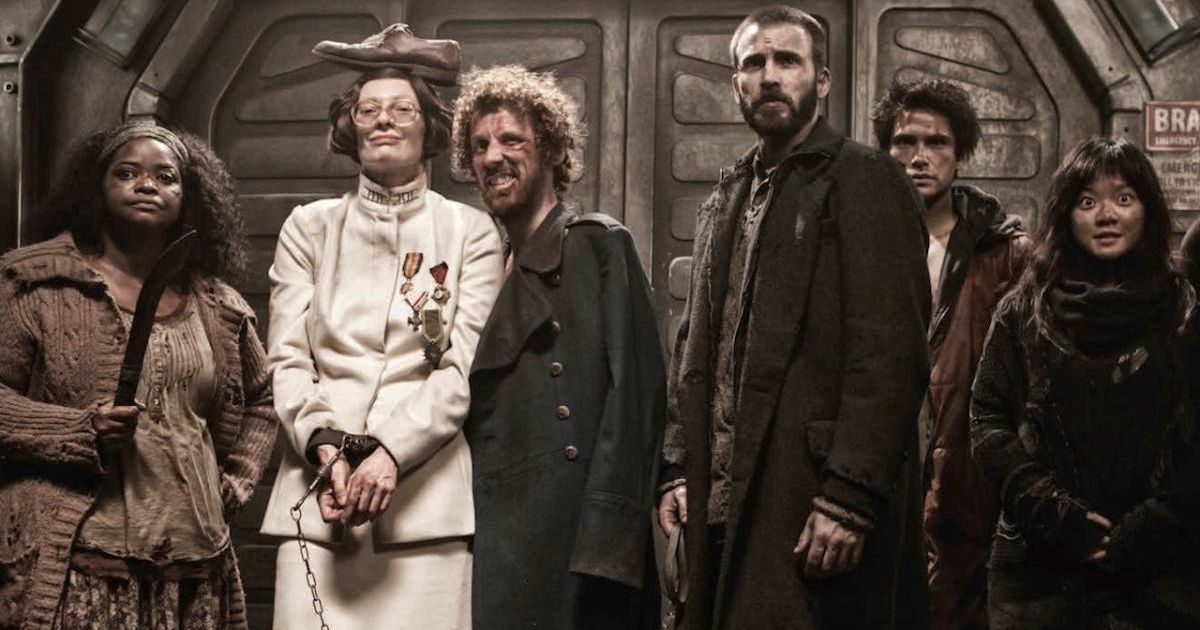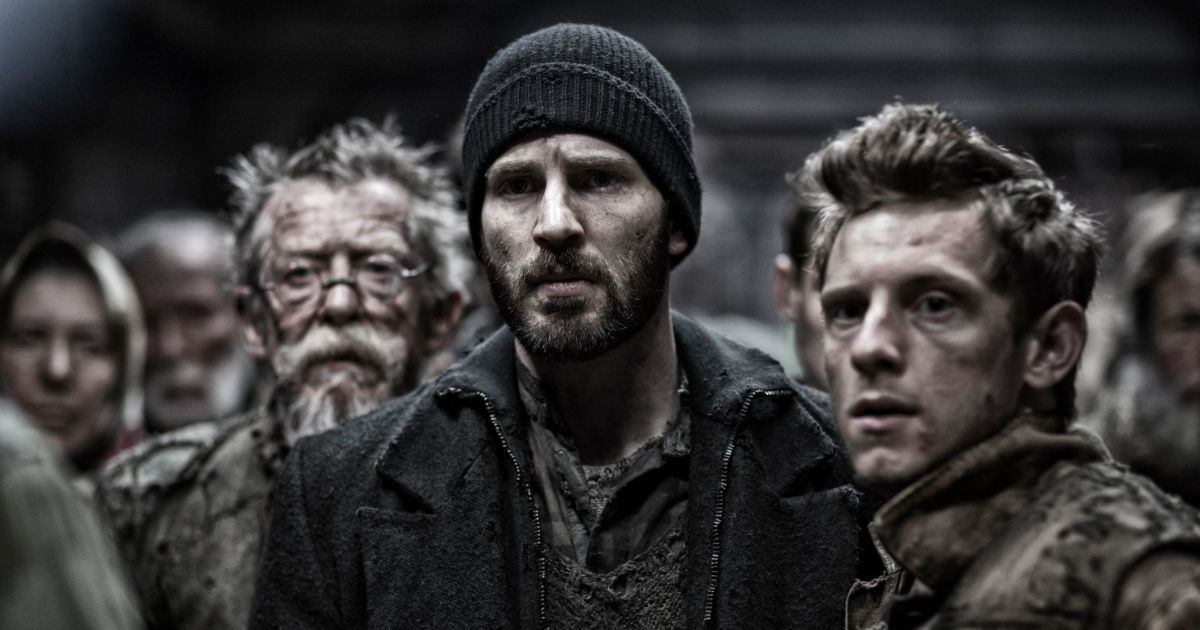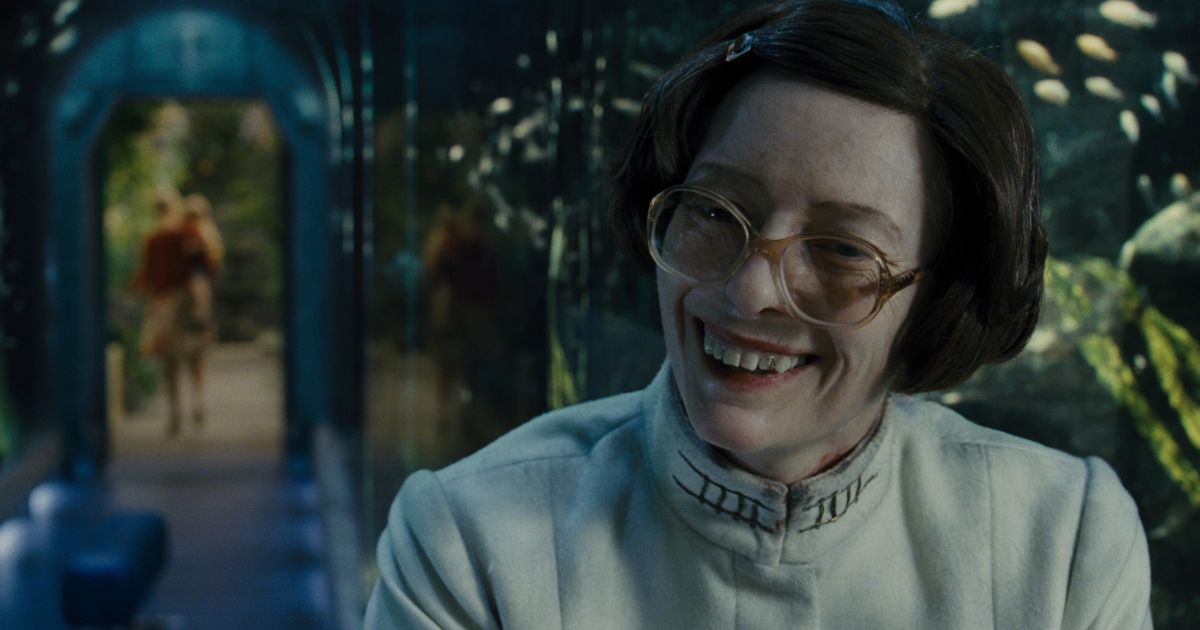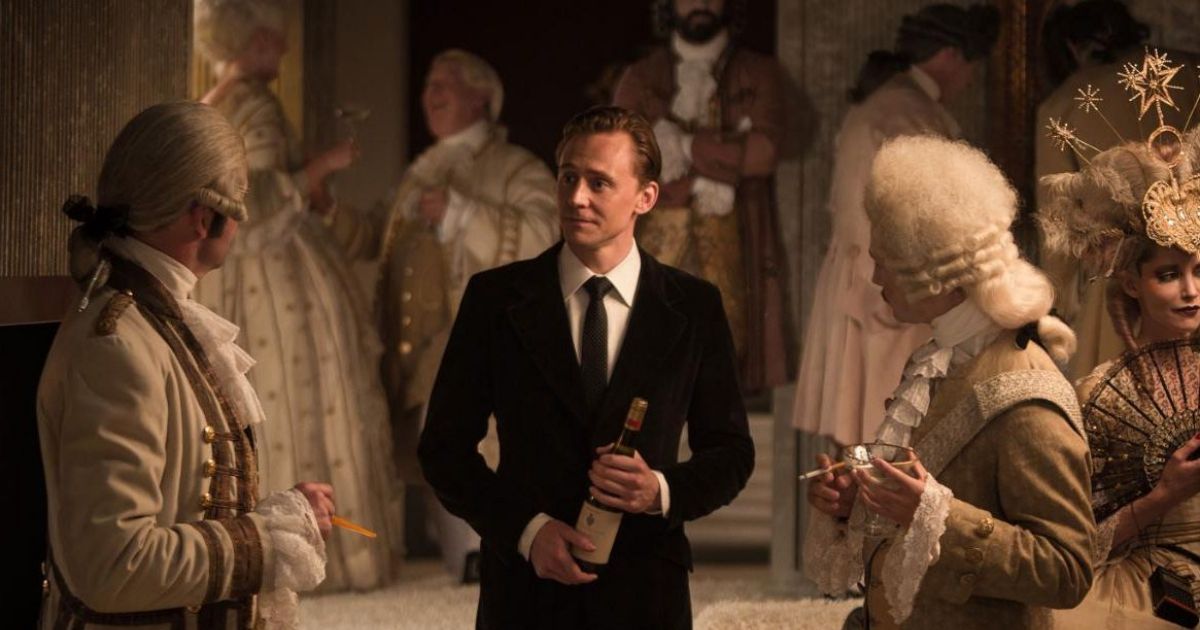Snowpiercer is a visually fantastic film with a strong lesson on society, class differences, class war, and environmental disaster. It is a futuristic dystopian science fiction film that takes place after an environmental catastrophe which wiped out almost all life from Earth. The few remaining survivors live on the Snowpiercer, a train that travels around the entire earth, fueled by a mysterious perpetual-motion engine.
As the film starts, the train has been traveling along its path during a modern ice age for the past 17 years. The train is arranged along strict class lines, with the poor in the tail of the train, where they eat nothing but disgusting fiber bars, and the rich passengers in front, enjoying the fanciest of foods and getting a world-class education for the kids. In between them is an army of soldiers who exist to protect the upper classes and suppress rebellions in the back, keeping the tail-end passengers in their miserable, dirty, grimy existence in the back of the train. This train is a metaphor for our world.
Snowpiercer Has a Revolutionary Plot
The capitalist satire and class-conscious critique are certainly grounded in real life, but the film is also based on realistic environmental situations. In Snowpiercer, the world started to end because of global warming, so a radical proposal was initiated. To combat global warming that was killing the earth, scientists proposed something called stratospheric aerosol injection. Massive amounts of aerosol are released into the atmosphere, which is supposed to have a cooling effect. The experiment goes radically wrong, bringing a new Ice Age to Earth, freezing it and killing all life except for the passengers of the Snowpiercer train.
At the front of the train is the futuristic and mysterious perpetual motion engine that takes the train around the world, over and over again. The mysterious and mythological Wilford, the designer, builder, and engineer of the great train, lives in a luxurious car at the very front. In his view, class division is a vital and necessary part of life aboard the Snowpiercer, where each caste, the haves and the have-nots, has its place.
In the 17 years he has operated the train there have been multiple violent uprisings, all suppressed by his private army. This time, Curtis (Chris Evans, Captain America himself), a passenger on the tail end, is leading what is called “The Curtis Revolution,” and the goal is to get to the front of the train and confront Wilford.
The train has a spatial class system, and in this revolution the tail passengers pass from one train car to the next and see for the first time how the rich live. While the tail is a filthy and overcrowded place where privacy does not exist, each successive car entered by the revolutionaries reveals more lavish and spacious environments.
The Rich Get Richer and the Poor Get Poorer in Snowpiercer
There is a car with a fancy kitchen where the passengers can eat escargot, a striking contrast to the grotesque protein bars passed out among the back-tail passengers. One of the film’s more disturbing moments occurs when we discover what exactly those bars are made of. There is a fancy prep school for the young, rich front passengers where, among other things, they watch propaganda videos about the mysterious Wilford, who had envisioned the Snowpiercer as a young child and has been obsessed with the idea ever since.
Curtis' revolt is more successful than past revolutions because he has the aid of supporting character Namgoong, played by Song Kang-ho (who appears in many of director Bong Joon-ho’s films), the architect of the train who knows all of its secrets. With him is Yona, his psychic daughter (played by Go Ah-sung). The two of them are addicted to Kronole, a drug that the user sniffs to get high, and which is popular in the front cars where the rich have nightclubs and parties. Namgoong hoards the stuff, but that is because it has a second function which we learn about at the end of the film.
Curtis, Namgoong, and a few others systematically advance further and further to the front of the train. The group also consists of an ancient one-legged Gilliam, played by John Hurt, who is somewhat of a father figure to Curtis, along with several parents searching for their children who had been abducted by the soldiers in the front section.
Tilda Swinton and Chris Evans Rule Snowpiercer
Standing in their way is not just an army, but Minister Mason, played to perfection by Tilda Swinton (We Need to Talk about Kevin). With her outlandish makeup, false teeth, and strange affect, she manages to steal every scene she is in. Looking a bit like a mutated Margaret Thatcher, she carries out Wilford’s demands, often brutally, overseeing massacres and tortures. She is the human face of the Snowpiercer. Her character was originally written for a man, and her subordinates refer to her as “Sir” throughout the film, but the wonderfully androgynous Swinton replaces gender with pure wickedness.
One of the first things we see Swinton's character do is make a man stick his arm out a window until it is frozen, then the arm is brought back in and smashed into little pieces, leaving her victim with just a stump. He is obsessed with finding his son and was punished for throwing a shoe. He’s not the only character searching for his young child. The soldiers go to the tail end and abduct all the very young children, who are never seen again. They are in fact the secret that keeps the Snowpiercer moving perpetually, and we learn the hideous truth only at the end — child labor and suffering allows the train to keep going forever.
The movie contains some great acting, but it is Tilda Swinton's transformative performance that steals the movie. Snowpiercer is a serious film, but it has a wicked sense of humor (like Parasite it is a very allegorical film, a parody of human divisions and class distinctions). Her character represents the face of the rich people on the train, and she is continually lecturing the poor passengers, some of whom are tortured. Her performance is over the top and hilarious, as well as sinister.
Special effects and makeup were required to make Curtis look pale and gaunt. Chris Evans’ huge muscles, as seen in Captain America and other films, had to be hidden because the passengers in the back of the train are malnourished, surviving off of just grotesque bars. Sporting a beard and a hardened intense look, Chris Evans is unrecognizable as revolutionary leader Curtis. This was a great idea, making him a much more relatable everyman rather than some jacked superhero.
Snowpiercer is More Than Just a Good Movie
Although the film presents liberal ideas about capitalism and class warfare, and the evils of class division, fascism, and child labor, the end reveals the film to be a lesson in nihilism. Curtis has no goal other than to get to the front of the train and confront Wilford. He does confront Wilford, just as his men succeed in blowing open one of the cars of the train, which triggers an avalanche that knocks the train of its tracks, killing just about everyone on board.
Curtis had never expressed any plans of how life would work after he conquers Wilford, possibly because there really is nothing anyone can do. All the passengers, rich and poor, are stuck on a train traveling around the globe for decades because life outside is a frozen wasteland. In this way, Snowpiercer reminds one of the pessimistic question of what happens after the revolution. Our politicians and corporate overlords are awful, but it's almost impossible by now to imagine a better, realistic future that replaces them. However, even with Snowpiercer's nihilistic ending, we are given a reason to hope that life is a force which can continue even in a frozen Ice Age Wasteland.
The film is from Korean director Bong Joon-ho, director of The Host and recipient of an Academy Award for Best Picture for the wonderful satire Parasite. His films have shown him to be a real visionary, and it must have been difficult filming this entire movie with just one location, the train. However, he pulls it off with spectacular results, creating a truly claustrophobic atmosphere while injecting it with his usual sociopolitical commentary.
High Rise, Snowpiercer, and the Class Divide
Snowpiercer is like JG Ballard’s novel High Rise (as well as the film adaption of the book), which also deals with class divisions that are represented spatially. The poor people remain on the bottom floors, while the hedonistic rich tenants live and party at the top, where the building’s architect resides. Fights break out between the bottom floor tenants and the top floor tenants until there is a class war being fought. It is a very interesting film, but the novel is superior in every way and makes its point more clearly.
In both these films, the poor and the rich, while in the same train or building, literally inhabit different worlds. The front (or top) is like a fancy hotel while the back (or bottom) is like a ghetto filled with hostile police telling everyone what to do. In between are the state's enforcers, the police and military who protect the private property of the elite and enforce laws which are written by the rich to mostly hurt the poor. High Rise is a fascinating head trip of a movie, but it is Snowpiercer which is truly great, an exciting and dark film that reflects a social reality which perpetuates inequality. It's a strong political statement, an angry cry on behalf of the have-nots, and a film for the people.




.jpg)
.jpg)
